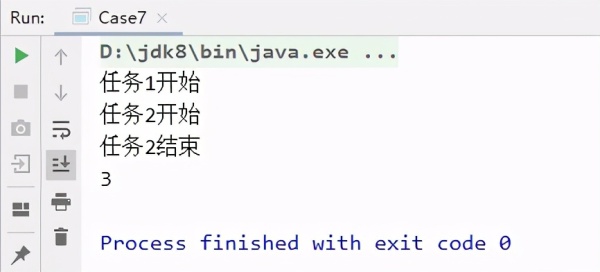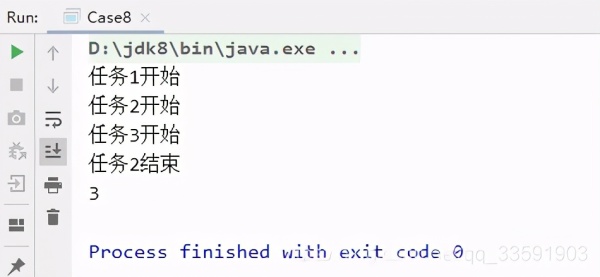您好,登錄后才能下訂單哦!
您好,登錄后才能下訂單哦!
這篇文章主要講解了“怎么使用CompletableFuture”,文中的講解內容簡單清晰,易于學習與理解,下面請大家跟著小編的思路慢慢深入,一起來研究和學習“怎么使用CompletableFuture”吧!

但Future機制,還不那么靈活,比如怎么去利用Future機制描述兩個任務串行執行,又或是兩個任務并行執行,又或是只關心最先執行結束的任務結果。
Future機制在一定程度上都無法快速地滿足以上需求,CompletableFuture便應運而生了。
public static <U> CompletableFuture<U> supplyAsync(Supplier<U> supplier) public static <U> CompletableFuture<U> supplyAsync(Supplier<U> supplier,Executor executor); public static CompletableFuture<Void> runAsync(Runnable runnable); public static CompletableFuture<Void> runAsync(Runnable runnable,Executor executor);
supplyAsync與runAsync的區別在于:supplyAsync有返回值,而runAsync沒有返回值
帶Executor參數的構造函數,則使用線程池中的線程執行異步任務(線程池可以參考說說線程池)
不帶Executor參數的構造函數,則使用ForkJoinPool.commonPool()中的線程執行異步任務(Fork/Join框架可以參考談談并行流parallelStream)
public class Case1 { public static void main(String[] args) throws Exception { CompletableFuture<Integer> completableFuture=CompletableFuture.supplyAsync(()->{ try { Thread.sleep(1000); } catch (InterruptedException e) { e.printStackTrace(); } return 1; }); //該方法會一直阻塞 Integer result = completableFuture.get(); System.out.println(result); } }public CompletableFuture<T> whenComplete(BiConsumer<? super T, ? super Throwable> action); public CompletableFuture<T> whenCompleteAsync(BiConsumer<? super T, ? super Throwable> action); public CompletableFuture<T> whenCompleteAsync(BiConsumer<? super T, ? super Throwable> action, Executor executor); public CompletableFuture<T> exceptionally(Function<Throwable, ? extends T> fn);
whenComplete開頭的方法在計算任務完成(包括正常完成與出現異常)之后會回調
而exceptionally則只會在計算任務出現異常時才會被回調
如何確定哪個線程去回調whenComplete,比較復雜,先略過。
而回調whenCompleteAsync的線程比較簡單,隨便拿一個空閑的線程即可,后綴是Async的方法同理。
package com.qcy.testCompleteableFuture; import java.util.concurrent.CompletableFuture; import java.util.concurrent.ExecutionException; import java.util.function.BiConsumer; import java.util.function.Function; import java.util.stream.IntStream; /** * @author qcy * @create 2020/09/07 17:40:44 */ public class Case2 { public static void main(String[] args) throws Exception { CompletableFuture<Integer> completableFuture = CompletableFuture.supplyAsync(() -> { try { Thread.sleep(1000); } catch (InterruptedException e) { e.printStackTrace(); } System.out.println("執行supplyAsync的線程:" + Thread.currentThread().getName()); int i = 1 / 0; return 1; }); completableFuture.whenComplete(new BiConsumer<Integer, Throwable>() { @Override public void accept(Integer integer, Throwable throwable) { System.out.println("執行whenComplete的線程:" + Thread.currentThread().getName()); if (throwable == null) { System.out.println("計算未出現異常,結果:" + integer); } } }); completableFuture.exceptionally(new Function<Throwable, Integer>() { @Override public Integer apply(Throwable throwable) { //出現異常時,則返回一個默認值 System.out.println("計算出現異常,信息:" + throwable.getMessage()); return -1; } }); System.out.println(completableFuture.get()); } }輸出:

當然,CompletableFuture內的各種方法是支持鏈式調用與Lambda表達式的,我們進行如下改寫:
public static void main(String[] args) throws Exception { CompletableFuture<Integer> completableFuture = CompletableFuture.supplyAsync(() -> { try { Thread.sleep(2000); } catch (InterruptedException e) { e.printStackTrace(); } System.out.println("執行supplyAsync的線程:" + Thread.currentThread().getName()); int i = 1 / 0; return 1; }).whenComplete((integer, throwable) -> { System.out.println("執行whenComplete的線程:" + Thread.currentThread().getName()); if (throwable == null) { System.out.println("計算未出現異常,結果:" + integer); } }).exceptionally(throwable -> { //出現異常時,則返回一個默認值 System.out.println("計算出現異常,信息:" + throwable.getMessage()); return -1; }); System.out.println("計算結果:" + completableFuture.get()); }public <U> CompletableFuture<U> thenApply(Function<? super T,? extends U> fn); public CompletableFuture<Void> thenRun(Runnable action); public CompletableFuture<Void> thenAccept(Consumer<? super T> action); public <U> CompletableFuture<U> handle(BiFunction<? super T, Throwable, ? extends U> fn); public <U> CompletableFuture<U> thenCompose(Function<? super T, ? extends CompletionStage<U>> fn);
thenApply,依賴上一次任務執行的結果,參數中的Function<? super T,? extends U>,T代表上一次任務返回值的類型,U代表當前任務返回值的類型,當上一個任務沒有出現異常時,thenApply才會被調用
thenRun,不需要知道上一個任務的返回結果,只是在上一個任務執行完成之后開始執行Runnable
thenAccept,依賴上一次任務的執行結果,因為入參是Consumer,所以不返回任何值。
handle和thenApply相似,不過當上一個任務出現異常時,能夠執行handle,卻不會去執行thenApply
thenCompose,傳入一次任務執行的結果,返回一個新的CompleteableFuture對象
package com.qcy.testCompleteableFuture; import java.util.concurrent.CompletableFuture; /** * @author qcy * @create 2020/09/07 17:40:44 */ public class Case4 { public static void main(String[] args) { CompletableFuture.supplyAsync(() -> 2) .thenApply(num -> num * 3) .thenAccept(System.out::print); } }很顯然,輸出為6
package com.qcy.testCompleteableFuture; import java.util.concurrent.CompletableFuture; import java.util.function.BiFunction; /** * @author qcy * @create 2020/09/07 17:40:44 */ public class Case4 { public static void main(String[] args) { CompletableFuture.supplyAsync(() -> 2) .thenApply(num -> num / 0) .thenApply(result -> result * 3) .handle((integer, throwable) -> { if (throwable == null) { return integer; } else { throwable.printStackTrace(); return -1; } }).thenAccept(System.out::print); } }最終會輸出-1
public <U,V> CompletableFuture<V> thenCombine(CompletionStage<? extends U> other, Function<? super T,? super U,? extends V> fn); public <U> CompletableFuture<Void> thenAcceptBoth(CompletionStage<? extends U> other, Consumer<? super T, ? super U> action); public CompletableFuture<Void> runAfterBoth(CompletionStage<?> other,Runnable action); public static CompletableFuture<Void> allOf(CompletableFuture<?>... cfs);
thenCombine,合并兩個任務,兩個任務可以同時執行,都執行成功后,執行最后的BiFunction操作。其中T代表第一個任務的執行結果類型,U代表第二個任務的執行結果類型,V代表合并的結果類型
thenAcceptBoth,和thenCombine特性用法都極其相似,唯一的區別在于thenAcceptBoth進行一個消費,沒有返回值
runAfterBoth,兩個任務都執行完成后,但不關心他們的返回結構,然后去執行一個Runnable。
allOf,當所有的任務都執行完成后,返回一個CompletableFuture
package com.qcy.testCompleteableFuture; import java.util.concurrent.CompletableFuture; import java.util.concurrent.ExecutionException; /** * @author qcy * @create 2020/09/07 17:40:44 */ public class Case5 { public static void main(String[] args) throws Exception { CompletableFuture<Integer> cf1 = CompletableFuture.supplyAsync(() -> { System.out.println("任務1開始"); try { Thread.sleep(3000); } catch (InterruptedException e) { e.printStackTrace(); } System.out.println("任務1結束"); return 2; }); CompletableFuture<Integer> cf2 = CompletableFuture.supplyAsync(() -> { System.out.println("任務2開始"); try { Thread.sleep(3000); } catch (InterruptedException e) { e.printStackTrace(); } System.out.println("任務2結束"); return 3; }); CompletableFuture<Integer> completableFuture = cf1.thenCombine(cf2, (result1, result2) -> result1 * result2); System.out.println("計算結果:" + completableFuture.get()); } }輸出:
可以看到兩個任務確實是同時執行的
當然,熟練了之后,直接使用鏈式操作,代碼如下:
package com.qcy.testCompleteableFuture; import java.util.concurrent.CompletableFuture; /** * @author qcy * @create 2020/09/07 17:40:44 */ public class Case6 { public static void main(String[] args) throws Exception { CompletableFuture<Integer> completableFuture = CompletableFuture.supplyAsync(() -> { System.out.println("任務1開始"); try { Thread.sleep(3000); } catch (InterruptedException e) { e.printStackTrace(); } System.out.println("任務1結束"); return 2; }).thenCombine(CompletableFuture.supplyAsync(() -> { System.out.println("任務2開始"); try { Thread.sleep(2000); } catch (InterruptedException e) { e.printStackTrace(); } System.out.println("任務2結束"); return 3; }), (result1, result2) -> result1 * result2); System.out.println("計算結果:" + completableFuture.get()); } }public <U> CompletableFuture<U> applyToEither(CompletionStage<? extends T> other, Function<? super T, U> fn); public CompletableFuture<Void> acceptEither(CompletionStage<? extends T> other, Consumer<? super T> action); public CompletableFuture<Void> runAfterEither(CompletionStage<?> other,Runnable action); public static CompletableFuture<Object> anyOf(CompletableFuture<?>... cfs);
applyToEither,最新執行完任務,將其結果執行Function操作,其中T是最先執行完的任務結果類型,U是最后輸出的類型
acceptEither,最新執行完的任務,將其結果執行消費操作
runAfterEither,任意一個任務執行完成之后,執行Runnable操作
anyOf,多個任務中,返回最先執行完成的CompletableFuture
package com.qcy.testCompleteableFuture; import java.util.concurrent.CompletableFuture; /** * @author qcy * @create 2020/09/07 17:40:44 */ public class Case7 { public static void main(String[] args) throws Exception { CompletableFuture<Void> completableFuture = CompletableFuture.supplyAsync(() -> { System.out.println("任務1開始"); try { Thread.sleep(3000); } catch (InterruptedException e) { e.printStackTrace(); } System.out.println("任務1結束"); return 2; }).acceptEither(CompletableFuture.supplyAsync(() -> { System.out.println("任務2開始"); try { Thread.sleep(2000); } catch (InterruptedException e) { e.printStackTrace(); } System.out.println("任務2結束"); return 3; }), result -> System.out.println(result)); //等待CompletableFuture返回,防止主線程退出 completableFuture.join(); } }輸出:

可以看得到,任務2結束后,直接不再執行任務1的剩余代碼
package com.qcy.testCompleteableFuture; import java.util.concurrent.CompletableFuture; /** * @author qcy * @create 2020/09/07 17:40:44 */ public class Case8 { public static void main(String[] args) throws Exception { CompletableFuture<Integer> cf1 = CompletableFuture.supplyAsync(() -> { System.out.println("任務1開始"); try { Thread.sleep(3000); } catch (InterruptedException e) { e.printStackTrace(); } System.out.println("任務1結束"); return 2; }); CompletableFuture<Integer> cf2 = CompletableFuture.supplyAsync(() -> { System.out.println("任務2開始"); try { Thread.sleep(2000); } catch (InterruptedException e) { e.printStackTrace(); } System.out.println("任務2結束"); return 3; }); CompletableFuture<Integer> cf3 = CompletableFuture.supplyAsync(() -> { System.out.println("任務3開始"); try { Thread.sleep(4000); } catch (InterruptedException e) { e.printStackTrace(); } System.out.println("任務3結束"); return 4; }); CompletableFuture<Object> firstCf = CompletableFuture.anyOf(cf1, cf2, cf3); System.out.println(firstCf.get()); } }輸出:

感謝各位的閱讀,以上就是“怎么使用CompletableFuture”的內容了,經過本文的學習后,相信大家對怎么使用CompletableFuture這一問題有了更深刻的體會,具體使用情況還需要大家實踐驗證。這里是億速云,小編將為大家推送更多相關知識點的文章,歡迎關注!
免責聲明:本站發布的內容(圖片、視頻和文字)以原創、轉載和分享為主,文章觀點不代表本網站立場,如果涉及侵權請聯系站長郵箱:is@yisu.com進行舉報,并提供相關證據,一經查實,將立刻刪除涉嫌侵權內容。